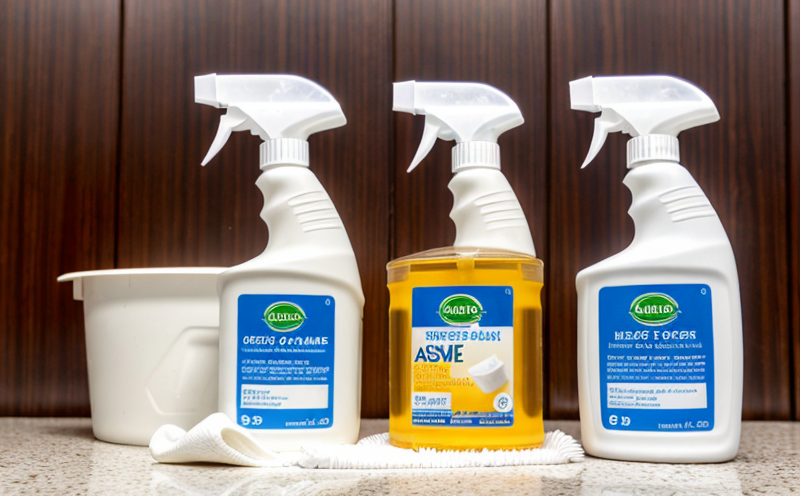ISO 6332 Foam Stability Testing of Cleaning Products
The ISO 6332 standard provides a method to determine the foam stability of cleaning products. This test is crucial for ensuring that the product maintains its intended foam characteristics throughout use, which directly impacts its effectiveness and user experience.
Foam stability is an essential property in many cleaning products as it enhances cleaning efficiency by increasing the contact area between the solution and the target surface. The test method involves measuring the height of a foam head formed from a specified volume of the product after mixing with water at specific conditions. This measurement helps in evaluating the product’s ability to generate and maintain foam, which is vital for products like soaps, shampoos, and detergents.
The process begins with accurate preparation of the cleaning product sample according to ISO 6332 guidelines. The sample should be free from any external contamination that could affect the test results. After mixing the sample with water in a specified ratio, the mixture is poured into a container and allowed to settle for a certain period. The foam height is then measured using a precision gauge.
Understanding the standard deviation of these measurements can provide insights into the consistency of the product’s foam properties. Variability in foam stability can be indicative of issues during manufacturing or formulation, which could affect the product's performance and user satisfaction. This test ensures that products meet quality standards and are consistent across different batches.
The importance of this test extends beyond just compliance with international standards; it also plays a role in brand reputation. Consistently high-quality foam stability can lead to customer loyalty, while poor performance may result in negative reviews and lost sales. By ensuring that the product meets ISO 6332 requirements, manufacturers can enhance their market position and consumer trust.
The test results are reported as the average foam height achieved under specified conditions. This data is valuable for quality control departments to monitor production processes and for R&D teams to optimize formulations. For procurement officers, this information ensures that they select suppliers who consistently deliver high-quality products.
In conclusion, ISO 6332 Foam Stability Testing of Cleaning Products is a critical step in the product development and manufacturing process. It not only ensures compliance with international standards but also enhances the overall quality and user satisfaction of cleaning products.
Why It Matters
The foam stability test, as defined by ISO 6332, is essential for several reasons. First, it directly impacts the effectiveness of cleaning products. Proper foam formation and maintenance are crucial for enhancing the cleaning process by increasing the contact area between the product and the surface to be cleaned.
Secondly, this test ensures consistency in product quality. Variability in foam stability can indicate issues during manufacturing or formulation that could affect the product's performance and user satisfaction. Consistent results from this test help manufacturers maintain high standards across different batches of products.
Thirdly, compliance with ISO 6332 is a key factor in maintaining brand reputation. Consumers are increasingly aware of quality and consistency in their purchases. Products that consistently meet international standards like ISO 6332 can enhance brand loyalty and trust, which are vital for long-term market success.
Finally, the test results provide valuable data for R&D teams to optimize formulations and quality control departments to monitor production processes. This information is crucial for continuous improvement and innovation in product development.
Eurolab Advantages
Eurolab offers comprehensive services that cater specifically to the needs of our clients operating within the chemical testing sector, particularly those involved in cleaning and hygiene product testing. Our state-of-the-art facilities are equipped with the latest equipment for accurate and reliable foam stability tests according to ISO 6332.
Our team of experts is well-versed in all aspects of this test method, ensuring that every step from sample preparation to final measurement is conducted precisely as per international standards. This expertise allows us to provide clients with consistent and accurate results, which are essential for maintaining product quality and meeting regulatory requirements.
We also offer a range of additional services that complement our foam stability testing capabilities. These include formulation development support, raw material analysis, and comprehensive quality assurance audits. Our multidisciplinary approach ensures that we can address all aspects of your chemical testing needs, providing you with the insights necessary to stay competitive in the market.
Why Choose This Test
The ISO 6332 foam stability test is a vital tool for ensuring that cleaning products meet both performance and regulatory requirements. By conducting this test, manufacturers can verify that their products generate the desired foam characteristics under controlled conditions.
This verification is crucial because it ensures that the product will perform as intended throughout its shelf life and usage period. Poor foam stability can lead to reduced cleaning efficacy and user dissatisfaction, which could negatively impact brand reputation and sales.
Moreover, compliance with ISO 6332 standards provides a clear benchmark for quality control. It allows manufacturers to monitor the consistency of their products across different batches and production runs. This consistency is essential for maintaining high-quality standards and ensuring that each batch meets the desired foam stability criteria.
The test also helps in identifying potential issues during the manufacturing process or formulation adjustments needed to optimize product performance. By detecting these issues early, manufacturers can make necessary corrections before the products reach the market, thereby reducing the risk of quality complaints and returns.





